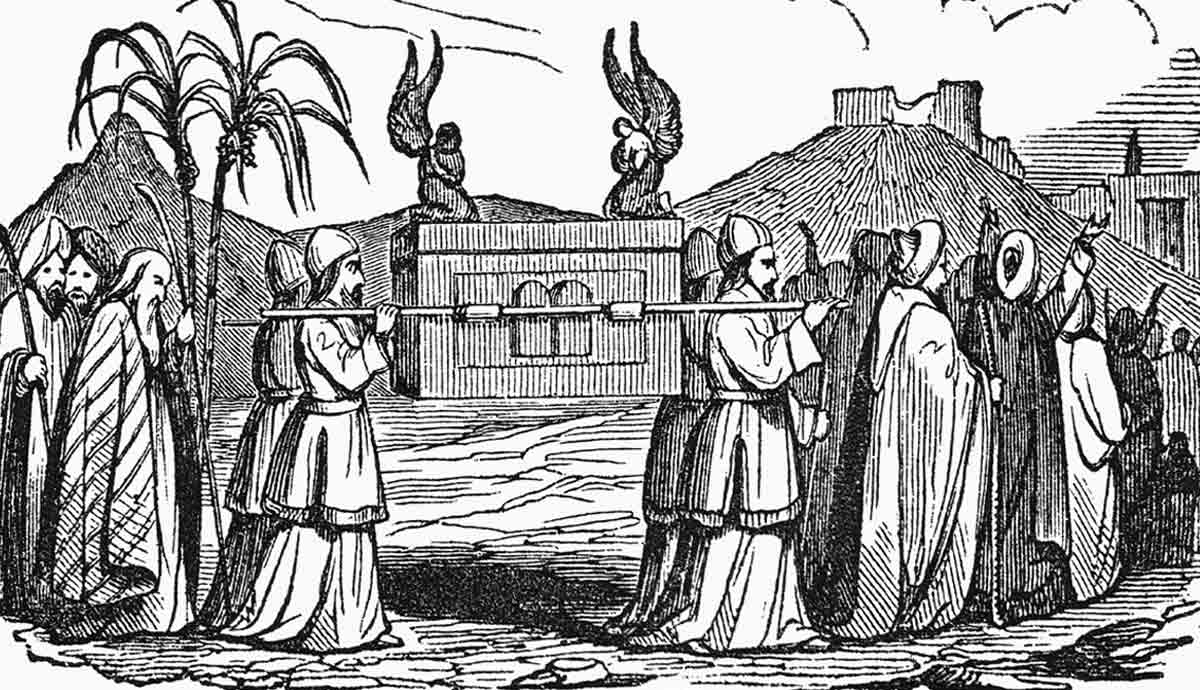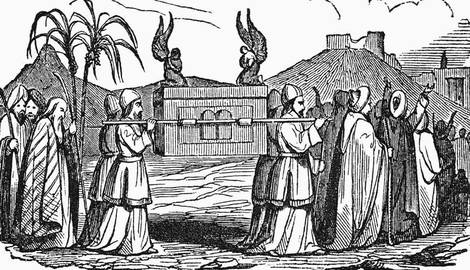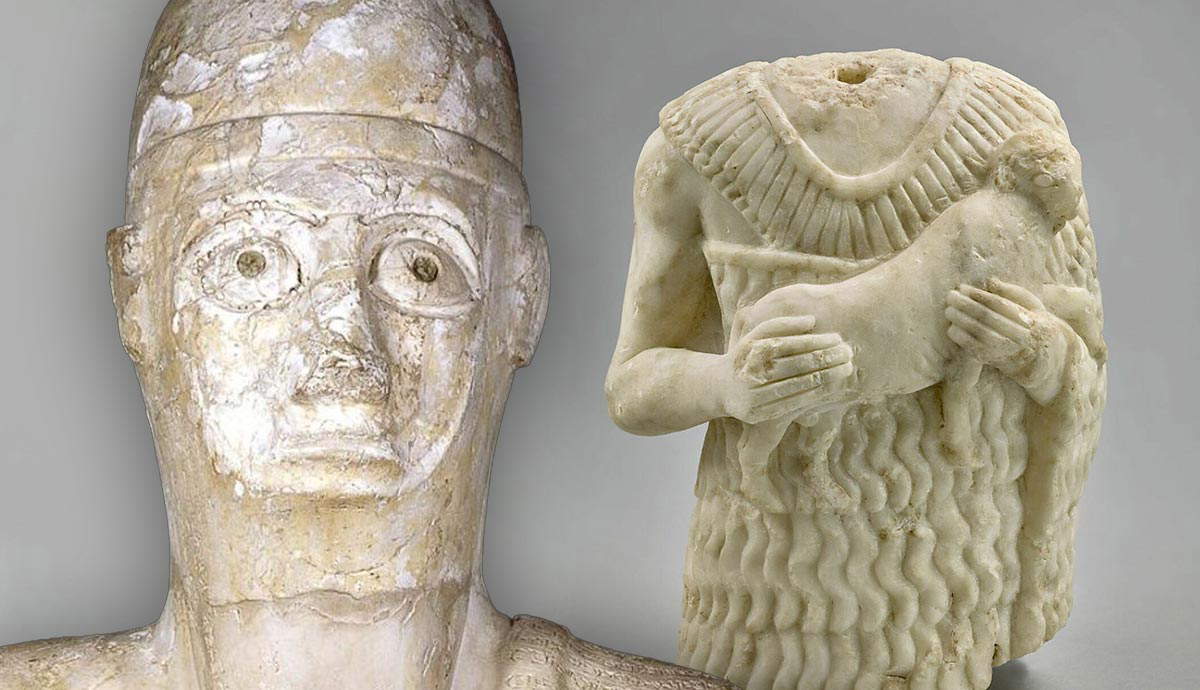
The ancient Israelites played an important role in the development of the three major Abrahamic religions: Judaism, Christianity, and Islam. This makes their history important, but it is also obscure. Their stories in the Old Testament may be fact or legend, and archaeologically they are hard to separate from the other inhabitants of the Middle East. Putting together the evidence that we do have for the ancient Israelites, what can we say about their history?
Origins and Identification

The precise identification of the early Israelites is difficult because it involves religious concepts that can evoke emotion. With that in mind, it is important to begin with a linguistic-cultural-anthropological identification of the people who would later become the Israelites.
It is also important to define some terms, such as Hebrews, Israelites, and Jews, which are often used interchangeably in the modern world. The term Israelites refers to the people from the kingdoms of Israel and Judah in the early first millennium BCE. Jew refers to followers of the ancient religion of the Israelites and those who practice the modern religion of Judaism. The earliest use of the term Jew in the Old Testament historical books is in 2 Kings (16:6). Israelite was generally used more widely and before that Hebrew was the preferred term.
The Hebrew people spoke a Semitic language that was closely related to the language spoken by various Canaanite peoples in the Levant during the Bronze Age. Philologists have further classified Hebrew as a member of the Northwest Semitic branch of the Semitic family. Other languages in this group include Moabite, Edomite, Ammonite, and perhaps most importantly, Phoenician.
Early Hebrew History

Little is known about the early history of the Hebrews due to the nature of the sources. The Hebrews were not a literate people in their early history and both archaeologically and anthropologically they resembled their Canaanite neighbors in many ways.
For the history of the Hebrews before the establishment of the Kingdom of Israel, the first five books of the Old Testament, known as the Pentateuch, are often used in concert with archaeological and Egyptian sources. Biblical scholars who view the historical events of the Old Testament as more or less accurate are often referred to as “maximalists,” while those who view the books more allegorically are “minimalists.”
Many biblical scholars begin the history of the Israelites in Egypt, which is partially recounted in the Old Testament book of Exodus. According to Genesis 12:10-19, Abraham traveled to Egypt. Some modern Egyptologists and biblical scholars believe this took place around 2116 BCE, or during Egypt’s 10th dynasty. Abraham then left Egypt but a remnant of the Hebrews who originally followed him may have remained. It was then Joseph the son of Jacob’s journey into Egypt that changed the Hebrews’ relationship with the Egyptians.

According to Genesis 41:29-36, Joseph was imprisoned for two years until he interpreted the pharaoh’s dream. Following this revelation, Joseph was appointed as the pharaoh’s vizier (Genesis 41:45-46), and a great number of Hebrews migrated into Egypt, called the “land of Rameses” (Genesis 47:11). Later the Hebrews were said to dwell in a part of Egypt known as “Goshen” (Genesis 47:27). None of these accounts are corroborated directly by Egyptian evidence, but there are several pieces of supporting circumstantial evidence.
Egyptian Evidence for Hebrews in Egypt

The Egyptian sources never mention the Hebrews or the Israelites by name during the period of the Hebrews’ sojourn in Egypt from about 2116 BCE to the middle 13th century BCE. The Egyptians referred to Canaanites and people from the Levant as Asiatics—A’am in ancient Egyptian—or by the specific location where they originated in the Levant.
The number of Asiatics in Egypt was considerable during the Middle Kingdom (c. 2055-1650 BCE), when the Egyptians expanded their influence into the Levant. Asiatics/Canaanites came flowing into Egypt, especially the Delta, as prisoners of war, slaves, and merchants. There were certainly Hebrews among them. As the population of Asiatics grew, they also gained influence.
The idea that the Hebrew Joseph could have become so influential in the Egyptian court is not without precedent. During the early New Kingdom (c. 1550-1279 BCE), a number of Canaanites are documented in Egyptian sources as having risen in the Egyptian political hierarchy. A man of Canaanite descent named Ben-ozen was the chief royal herald and chief of the department of alimentation and beverages under Ramesses II (ruled c. 1279-1213 BCE). Perhaps the most important Asiatic/Canaanite in ancient Egypt was a man named Bay, who in the late 19th dynasty (13th/12th centuries BCE) rose to the position of chancellor.
Historicity of the Biblical Exodus

Egyptian sources indicate that many of the events involving the Hebrews related in the early sections of the Old Testament were possible, if not likely. A further examination of the book of Exodus can help pinpoint when many of those events might have taken place. Exodus 1:11 states that the Hebrews “built for Pharaoh treasure cities, Pithom and Raamses.” Once again, the Egyptian sources can at least partially corroborate this passage and identify these two locations.
The pharaohs of the Ramesside era—the 19th and 20th dynasties (c. 1295-1069 BCE)—routinely settled large foreign populations in the Delta. For example, Ramesses II settled large numbers of the Sea Peoples known as the Shardana/Sherden, who were then used as mercenaries in the Egyptian army. Some modern scholars argue that the biblical Raamses was the city of Per-Ramesses Aa-nekhet, while Pithom was Per-Atum. Both cities were located in the Delta and built during the reign of Ramesses II. Unfortunately, most of the archaeology in the Delta has been lost due to a combination of the high water table and the modern reuse of temple bricks.
Conquest of Canaan

The manner in which the Israelites left Egypt is open to speculation, though some scholars believe it could have more or less followed the book of Exodus. According to Numbers 32:13, the Israelites wandered in the southern Levant for forty years before settling in their home. Some scholars argue that the Israelites’ conquest of Canaan began around 1456 BCE. This would have taken place during the reign of Thutmose III (ruled c. 1479-1425 BCE) or Amenhotep II (reigned c. 1427-1400 BCE) during the 18th dynasty of the New Kingdom.
On the other hand, others argue that the mention of Ramesses in Exodus, and the extensive building activity, fits more closely with Ramesses II. Either way, the first mention of Israel in a non-biblical source is a historical stela from the reign of the Egyptian king Merenptah (ruled c. 1213-1203 BCE). The text recounts a number of lands and people in the Levant that Merenptah defeated, including this important reference: “Israel is desolated, his seed is not.”
Kingdoms of Israel and Judah

Merenptah may have temporarily defeated the Israelites, but about 200 years after that event the Israelites had transitioned from a tribal society to a kingdom. For the early history of Israel as a state, modern scholars primarily refer to the historical books of Samuel. According to these books, Saul (ruled c. 1042-1010 BCE) was the first king of Israel (1 Samuel 8:10).
The book also relates how the Israelites were under the rule of the coastal dwelling people known as the Philistines, who took the Israelites’ iron weapons (I Samuel 13:17-19). The low point for the Israelites during this period was their defeat by the Philistines at the Battle of Aphek, which modern scholars date to 1060/1050 BCE.
The role of the Philistines in the early history of the Kingdom of Israel is another important historical point. Most modern historians and archaeologists now believe that the Philistines arrived in the Levant during the Bronze Age collapse of c. 1200 BCE. It appears that the Peleset who attacked Egypt in the early 12th century BCE went to the southern Levant afterwards and became the biblical Philistines. The Peleset originated in the Aegean Sea and after landing in the Levant they adopted Canaanite archaeological attributes, developing a hybrid culture in the process.

After Saul’s rule, Israel’s two greatest kings came to the throne – King David (c. 1010-970 BCE), and his son Solomon (970-931 BCE). According to 2 Samuel 21:15-22, David decisively defeated the Philistines, paving the way for an era of peace, wealth, and stability.
Solomon inherited his father’s alliance with King Hiram I (c. 980-947 BCE) of the Phoenician city-state of Tyre, using the kingdom’s wealth to build the Great Temple (1 Kings 1-11; 2 Chronicles 1-9). The rule of Solomon would prove to be Israel’s apex because, after that, internal divisions and stronger neighbors proved the undoing of the kingdom.

Division of the Kingdom

After Solomon died, Israel devolved into petty squabbling and quickly divided into two dynasties. Feeling burdened by heavy taxes, the tribes of Judah and Benjamin formed the Kingdom of Judah in the south. Judah’s first king was Rehoboam (ruled c. 931-915 BCE), while the rule of Israel passed to Jeroboam I (reigned c. 931-911 BCE). Jerusalem became the capital city of Judah, and in the north King Omri (ruled c. 882-871 BCE) built the city of Samaria as Israel’s capital.
The division of Israel came at a bad time. A revived Egypt under the Libyan-descended Pharaoh Shoshenq I (ruled c. 945-924 BCE) was attempting to retake territories in the Levant that Egypt had lost after the collapse of the New Kingdom. Shoshenq took advantage of the division by supporting Jeroboam, which eventually led to an Egyptian military campaign in Judah and Israel. This happened in the 5th year of Jeroboam I’s rule.
The campaign is recounted in 1 Kings 14:25-26 and 2 Chronicles 12:2-5, where Shoshenq I is called Shishak. The campaign is corroborated by a collection of texts and pictorial relief from the Egyptian temple of Karnak that are today known as the Bubastite Portal. The text lists the more than sixty towns Shoshenq plundered, with those of Israel listed first, followed by Judah.

It is believed that the main thrust of the Egyptian invasion went into Judah, with a smaller strike force hitting different locations in Israel. In addition to the list of the cities the Egyptians raided, the Bubastite Portal notes how the Israelites suffered serious casualties during the campaign.
“I made the southerners come in obeisance to thee, and the Northerners to the greatness of thy fame. Thou hast made a great slaughter among them without number, falling in their valleys, being multitudes, annihilated and perishing afterward, like those who have never been before.”
Shoshenq I’s campaign proved to be more of a raid, as the Egyptians did not occupy either kingdom. However, the damage they did to the kingdoms was likely quite significant and made the Israelites unable to oppose later, stronger enemies. The Moabite Stone/Mesha Stele is a Canaanite inscription that relates how King Mesha of Moab defeated the House of Omri around 840 BCE. It would be just another defeat in a long line the Israelites would suffer.
The Assyrian and Babylonian Captivities

Within a few decades of Shoshenq’s campaign against Israel, the northern kingdom was still weak and became a vassal of the Assyrian Empire by the mid-19th century BCE. Judah would hold out until the late eighth century, but during that time the kings of Israel attempted to reassert their independence. According to 2 Kings 18:9-10, the Assyrian King Shalmaneser V (726-722 BCE) besieged Samaria while Hoshea (732-722 BCE) was the king of Israel. The Assyrian sources corroborate this, although Sargon II (721-705 BCE) was the king. The discrepancy is probably the result of Sargon seizing the throne from his brother Shalmaneser in a palace coup during the siege. He then ended the siege during his rule in 722 BCE.
“From the year of my accession to the fifteenth year of my reign, I brought about the defeat of Humbanigash, the Elamite, in the plain of Der. I besieged and captured Samaria, carrying off 27,290 of the people who dwelt therein.”
The Assyrian and Babylonian practice of forcibly resettling rebellious populations became standard policy during the rule of the Assyrian King Ashurbanipal (884-859 BCE). Therefore, the end of the Kingdom of Israel and the dispersal of its people is corroborated by historical texts as well as circumstantial evidence.

The kings of Judah avoided the wrath of the Assyrians by following a more diplomatic path, and after the Assyrian Empire collapsed they probably thought they were safe. But the Assyrian Empire was replaced by the Neo-Babylonian Empire as the rulers of the Near East. The last three kings of Judah decided to test their Babylonian overlords, which is related in 2 Kings 24. According to 2 Kings, Jehoiakim (609-598 BCE), Jehoiachin (598-597 BCE), and Zedekiah (597-586 BCE) all rebelled against Babylon.
The Babylonian king Nebuchadnezzar II (604-562 BCE) ordered a siege of Jerusalem in 597 BCE and for all of its valuables, including the royal family, to be brought to Babylon. Nebuchadnezzar then placed Jehoiachin’s uncle, Zedekiah, on the throne but he too rebelled (2 Kings 24:20). Finally, in 587 BCE, the Babylonians took Zedekiah away in chains to Babylon and tore down the walls of Jerusalem (2 Kings 25:10). A good portion of Judah’s population was taken into captivity and its royal dynasty ended. A cuneiform tablet from Babylon corroborates Nebuchadnezzar’s siege and destruction of Judah.
“Year seven, month Kisumu: The king of Akkad moved his army into Hatti land, laid siege to the city of Judah and the king took the city on the second day of the month Addaru. He appointed in it a (new) king of his liking, took heavy booty from it and brought it into Babylon.”
This marked the end of Israel’s era as an independent kingdom and its political influence in the Near East. With that said, Israel continued to influence ancient religion, giving birth to the three major Abrahamic religions of today.










